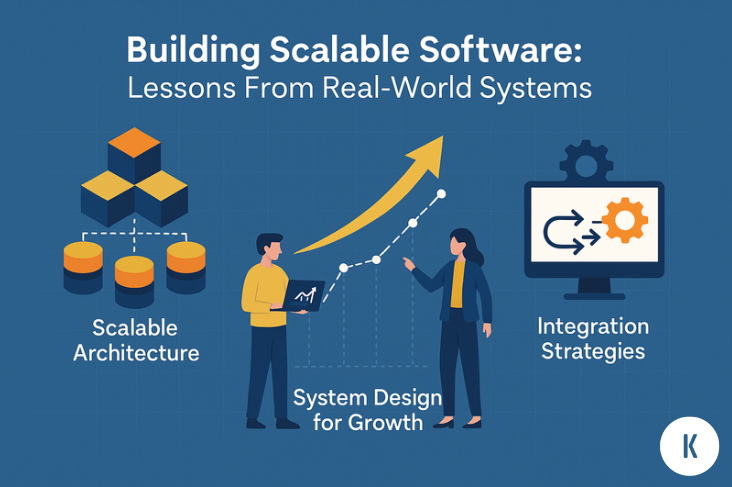Introduction: Why Scalability Is Not Optional Any More It’s a digital first world today, and scalability isn’t simply a technical requirement – it’s strategic. You’re starting a SaaS platform, an eCommerce engine, or a data analytics portal; whatever it is, Building Scalable Software Systems to match the growth of your business isn’t debatable.
We’ve seen it all at Kahnputers: from startups struggling with unforeseen user growth to companies stuck in legacy code and can’t deal with today’s demands. The common denominator? No planning for scale. Here’s how we build scalable software systems for our actual clients – so your app prospers, not merely survives, growth.
1. What is It That Makes Software Scalable? Let’s start with what scalability looks like.
A scalable software system can:
- Handle more users without slowing down
- Handle more features without crashing
- Handle more data without losing speed or accuracy
Scalability is not vertical (adding more power to a single server) or horizontal (adding more servers) – it’s a matter of architecture. It’s a question of building software that flexes, but doesn’t break.
Some key attributes of scalable systems:
- Stateless APIs: Replicable, fault-tolerant endpoints
- Service-Oriented Architecture (SOA) or Microservices: Decouple functionality to scale out independently
- Cloud-native deployment: Leverage autoscaling, containerization, and distributed storage
- Database optimization: Indexing, sharding, and read replicas
- Async task processing: Background queues to offload heavy operations
2. Real-World Example: Scaling an eCommerce Platform We had one of our eCommerce customers come in with an emergency: their system was built for 100 users but had scaled to 10,000. Pages were timing out. Orders weren’t syncing. Customer support was overwhelmed.
We leaped in and re-architectured the backend with a microservices-based approach on AWS. We broke the app into standalone services for:
- User management
- Product listings
- Inventory
- Order processing
- Payment handling
Each of which could scale independently with Amazon ECS, and event-driven tasks like sending order confirmations were managed by AWS Lambda. Redis caching sped up product search and PostgreSQL read replicas reduced DB bottlenecks.
Within 45 days, we achieved:
- 5× faster page loads
- 99.99% uptime during high traffic
- 3× more orders in parallel without queuing delays
👉 Lesson: Scaling isn’t a patch – it’s a redesign. Start modular, or make yourself go modular later.
3. The Pillars of Scalable Architecture You can’t construct skyscrapers on a wobbly foundation. Neither can you construct software. Here’s what we concentrate on when building scalable architecture:
a. Layered Design Separate concerns into:
- Presentation layer (UI/UX)
- Application logic
- Data access
- Integration/messaging
This separation allows independent upgrades, testing, and scaling.
b. Statelessness Don’t store user session data on the server. Use auth with tokens (e.g., JWT). Stateless APIs are easier to scale and easier to deploy behind load balancers.
c. Infrastructure-as-Code (IaC) We have scalable infrastructure that is version-controlled, testable, and repeatable through Terraform or AWS CloudFormation.
d. Elastic Resources Use cloud platforms (AWS/GCP/Azure) with autoscaling groups, S3 for object storage, and managed services such as DynamoDB or Aurora Serverless.
4. Designing for Growth: What Most Teams Overlook Far too many CTOs and founders architect to ship day, rather than day 1,000. At Kahnputers, we bake scalability into the system design – not as an afterthought, but as a fundamental principle.
Of our top strategies that we apply:
- Load testing early: Employ k6 or Locust to load test 10x expected traffic.
- Failover planning: Redundancy across zones and database backups.
- Modular APIs: Each endpoint can be versioned and expanded without breaking.
- Database growth planning: Partition tables, avoid SELECT *, paginate, and normalize thoughtfully.
It prevented one SaaS customer from a catastrophe during a viral event. Their app handled 20,000 signups across 3 days—with zero downtime.
5. Scaling Integration Strategies That Scale with You Integrations become the silent killer of performance when misdone. We’ve witnessed businesses take months to fix slow or failed sync jobs across platforms.
At Kahnputers, we build integration strategies that are:
- Asynchronous: Use queues like RabbitMQ, SQS, or n8n to decouple systems
- Retry-safe: Use exponential backoff for retrys
- Rate-limited: Respect API rates of third-party providers
- Monitored: Build internal dashboards to view integration health and failures
We recently built a sync engine that synced 5 marketplaces (Amazon, Walmart, Etsy, Shopify, eBay) to a customer’s master inventory system. With event-driven architecture and deduplication logic, the system now handles 50K+ updates per day with <1% error rate.
👉 Lesson: Develop your integrations as if they are external apps – because one day they will be.
6. Scaling Is Ongoing – Not One and Done Scalability is not a flip you switch. It’s iterative. It’s ongoing optimization, feedback loops, and monitoring.
What we help customers deploy at Kahnputers:
- Logging & Monitoring: Grafana, Prometheus, CloudWatch software
- Alerting: Slack + PagerDuty for immediate incident response
- Feature Flags: Safely deploy new features without full rollout
- Resource Profiling: Track API and DB usage to find bottlenecks
- CI/CD Pipelines: Automated tests and zero-downtime deployments
We believe that every company should care for their software like it were a living organism – monitoring its health, watching what it’s doing, and transforming it to the environment.
7. Refactor or Bust: Scaling Beyond Your MVP If you have already deployed an MVP and faced performance bottlenecks, don’t panic. It’s normal. Here is a lightning-fast checklist we use to decide when to refactor:
| Symptom | Potential Fix |
|---|---|
| High DB CPU usage | Add read replicas or query optimization |
| API timeouts | Introduce background jobs or caching |
| Deployment issues | Move to Docker + CI/CD |
| Poor UX under load | Load balance + use CDNs |
| Integration delays | Migrate to event-based sync |
We’ve guided multiple founders through this phase and helped convert fragile MVPs into revenue-grade platforms.
Conclusion: Build to Scale, or Prepare to Rebuild If there’s one truth in tech, it’s this: Every system will eventually be pushed beyond its limits. The question is – will yours break or adapt?
At Kahnputers, we specialize in building scalable software systems that scale as fast as your company scales. Pre- or post-Series A, we’ll help you build the right foundation, make the right tech stack choices, and make data-driven bets that future-proof your operations.


